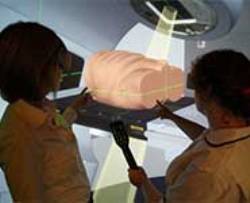Apr 22 2013
Researchers at the Universities of Bristol and Cardiff will today [Friday 19 April] show how groundbreaking ultra high definition (UHD) technology is making a real difference in remote medical training and diagnosis, with 3D demonstrations on a ‘virtual patient’.
 The CURVES suite at Cardiff showing an immersive training session involving two trainee radiographers positioning a virtual patient and enacting a treatment fraction from a virtual LINAC. Image by Cardiff University
The CURVES suite at Cardiff showing an immersive training session involving two trainee radiographers positioning a virtual patient and enacting a treatment fraction from a virtual LINAC. Image by Cardiff University
Already used by trainee radiographers at Cardiff University, UHD technology, using the UK’s research and education high-speed data network Janet, has the potential to revolutionise the way medical training is conducted. It will not only free up treatment rooms for patients but also enable students to grow their competences in a virtual world before treating 'actual' patients. By sharing resources with other sites significant savings could also be made, as well as enabling shared expertise.
Nick Avis, Professor of Interactive Visualization and Virtual Environments at Cardiff University’s School of Computer Science & Informatics, said: “The great thing about UHD video is that it enables us to use high fidelity visuals to replicate the human body, which are critical for modern diagnostics. However, delivering this data-intensive1 digital media to remote users, whilst retaining high visual quality, requires high-speed networking and infrastructure.
“We are fortunate to be able to use Janet’s high capacity data network to collaborate with research partners and push the boundaries of this technology, not only in the UK but internationally too.”
Today’s demonstration will show radiographers at Cardiff’s Healthcare Studies undergoing training on a ‘virtual patient’ using 3D technology that brings to life an area of the body in need of treatment. The streams, of 4-8K content (that’s 4 – 8 times the resolution of normal HD) will also be shared with other sites at Bristol and PSNC (The Poznan Supercomputing and Networking Centre in Poland). A second demonstration will show computational modelling on arterial cells - the results of a collaboration with the Cardiovascular Sciences Research Group based at the Wales Heart Research Institute in Cardiff.
Dimitra Simeonidou, Professor of High Performance Networks in the Department of Electrical & Electronic Engineering at the University of Bristol, explained: “For remote applications, such as real time medical training to thrive, the network infrastructure must become dynamic and readily consumable. A fundamentally new approach is required in the way we design today's networks.
“The High Performance Networks group at Bristol develops ground-breaking technology which automates any network infrastructure, transforming it into a reflexive environment that instantaneously establishes network services at global scales. Today we demonstrate the benefits of such technologies using the medical training platform at Cardiff as exemplar application.”
This showcase is the first of two run by the UK UHD consortium, consisting of the Universities of Cardiff, Bristol and Strathclyde, and Glasgow School of Art. This group is the first of its kind in the country to build an integrated networked infrastructure for research into novel multimedia techniques and networking architectures. Through their work, the group aims to develop and deploy the next generation of networked UHD applications.
Emma Smith, Video Projects Co-ordinator at Janet, added: “Ultra High Definition is the next generation of high fidelity digital media. Until now it has been most heavily associated with the entertainment industry and more recently large-screen coverage of the 2012 Olympics.
“This research will not only benefit research and education, but also has the potential to enable virtual museums/tourism, performing arts collaborations and many more. We are pleased to be able to support these types of collaborations over Janet.”
Already other research into UHD technology is taking shape as a direct result of this project. This includes a proposal for an EU/Brazil partnership to explore the infrastructure requirements to combine technical developments in cloud technology and the use of high definition content. It may yet be some years off, but as research in this area develops we may start to see its deployment across a wider range of disciplines, and eventually across mainstream video.
A second showcase will take place later in the year at Glasgow School of Art to further demonstrate the use of this technology.